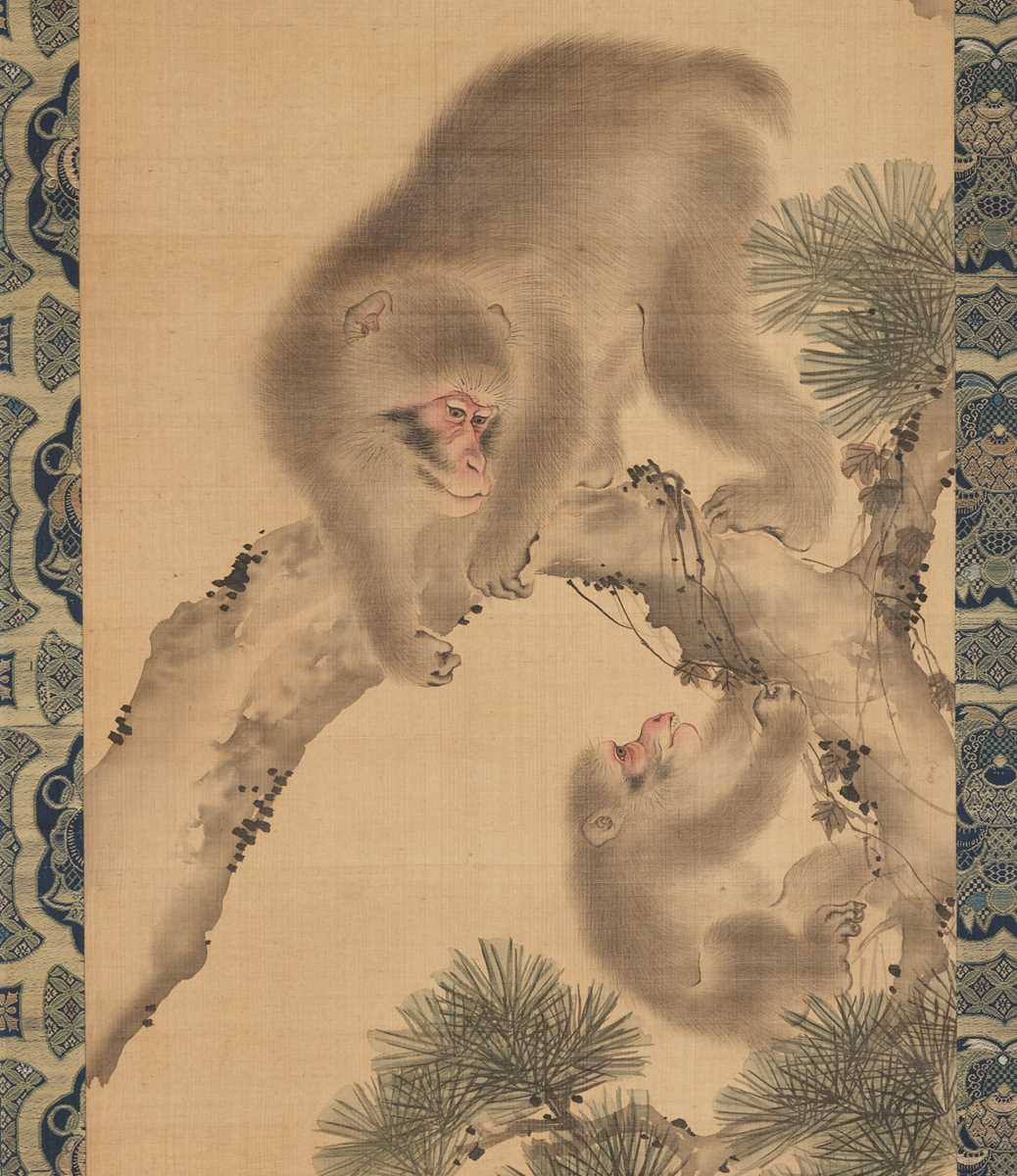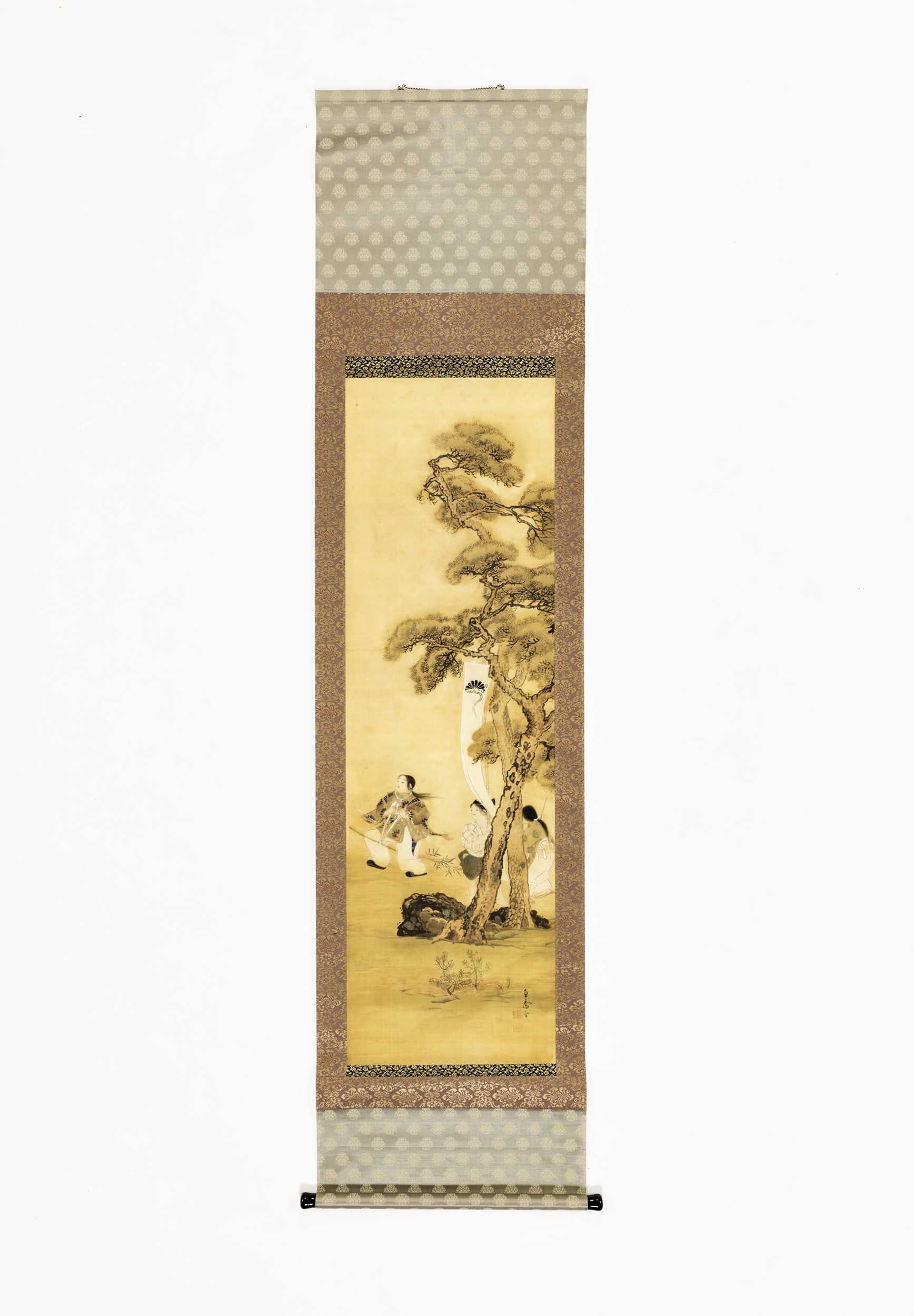Lot details Inscribed Kamei and sealed Anagura and Kameisai Japan, Kyoto, late 18th – early 19th century, Edo period (1615-1868) Finely painted in ink and watercolors on silk, with a silk brocade frame and mounted as a hanging scroll, depicting a tiger standing foursquare on a rocky slope, with brown leaves and twisted vines and roots in the background, as well as bamboo leaves below the tiger, calling to mind the popular motif take no tora (tiger in bamboo). The tiger’s striped fur is neatly detailed and both its large side-glancing eyes and dynamic pose suggest a certain mischief to the mysterious animal. Inscribed and signed center right, ‘KAMEI shujin, Heian shuchikuro chu ni oite utsutsu’ (‘Painted by Master Kamei, at the Shuchikuro Studio, Kyoto’). SIZE 103 x 51 cm (image) and 178 x 67 cm (total) Condition: Very good condition with minor wear, creasing, little soiling, the brocade frame with few minuscule losses to edges. Provenance: From a private collection, Illinois. Although there is no information available about this artist, it is likely that he was a follower of Maruyama Okyo (1733-1795). The name Kamei literally means ‘Turtle Abode’. Maruyama Okyo and his students painted numerous paintings for the Daijoji Temple, whose mountain name (sango) is Kamei Temple (also known as Okyo Temple); the commission was carried out at the Okyo's studio in Kyoto, though the Kamei Temple (Okyo Temple) is located in nearby Hyogo. Tiger imagery has a long history in East Asia. Tigers were frequently paired with dragons—the tiger representing the ‘male’ principle, the yin to the female ‘yang’ of the dragon, ancient cosmological symbols. Tigers are also commonly paired with bamboo, which is known as take no tora, or ‘tiger in bamboo’, and has many different interpretations; the tiger has a strong nature, is flexible and resilient like the bamboo, but it is also said that the strong tiger is looking for shelter underneath the bamboo, as any earthly power is inferior to the forces of nature. Moreover, the tiger and bamboo represent the power of faith in Buddhism. Auction comparison: Compare a closely related painting of a tiger, described as “School of Maruyama Okyo”, 104 x 15.5 cm, at Christie’s, Japanese & Korean Art, 23 March 2011, New York, lot 879 (sold for 10,000 USD).
Lot details Inscribed Kamei and sealed Anagura and Kameisai Japan, Kyoto, late 18th – early 19th century, Edo period (1615-1868) Finely painted in ink and watercolors on silk, with a silk brocade frame and mounted as a hanging scroll, depicting a tiger standing foursquare on a rocky slope, with brown leaves and twisted vines and roots in the background, as well as bamboo leaves below the tiger, calling to mind the popular motif take no tora (tiger in bamboo). The tiger’s striped fur is neatly detailed and both its large side-glancing eyes and dynamic pose suggest a certain mischief to the mysterious animal. Inscribed and signed center right, ‘KAMEI shujin, Heian shuchikuro chu ni oite utsutsu’ (‘Painted by Master Kamei, at the Shuchikuro Studio, Kyoto’). SIZE 103 x 51 cm (image) and 178 x 67 cm (total) Condition: Very good condition with minor wear, creasing, little soiling, the brocade frame with few minuscule losses to edges. Provenance: From a private collection, Illinois. Although there is no information available about this artist, it is likely that he was a follower of Maruyama Okyo (1733-1795). The name Kamei literally means ‘Turtle Abode’. Maruyama Okyo and his students painted numerous paintings for the Daijoji Temple, whose mountain name (sango) is Kamei Temple (also known as Okyo Temple); the commission was carried out at the Okyo's studio in Kyoto, though the Kamei Temple (Okyo Temple) is located in nearby Hyogo. Tiger imagery has a long history in East Asia. Tigers were frequently paired with dragons—the tiger representing the ‘male’ principle, the yin to the female ‘yang’ of the dragon, ancient cosmological symbols. Tigers are also commonly paired with bamboo, which is known as take no tora, or ‘tiger in bamboo’, and has many different interpretations; the tiger has a strong nature, is flexible and resilient like the bamboo, but it is also said that the strong tiger is looking for shelter underneath the bamboo, as any earthly power is inferior to the forces of nature. Moreover, the tiger and bamboo represent the power of faith in Buddhism. Auction comparison: Compare a closely related painting of a tiger, described as “School of Maruyama Okyo”, 104 x 15.5 cm, at Christie’s, Japanese & Korean Art, 23 March 2011, New York, lot 879 (sold for 10,000 USD).















Testen Sie LotSearch und seine Premium-Features 7 Tage - ohne Kosten!
Lassen Sie sich automatisch über neue Objekte in kommenden Auktionen benachrichtigen.
Suchauftrag anlegen